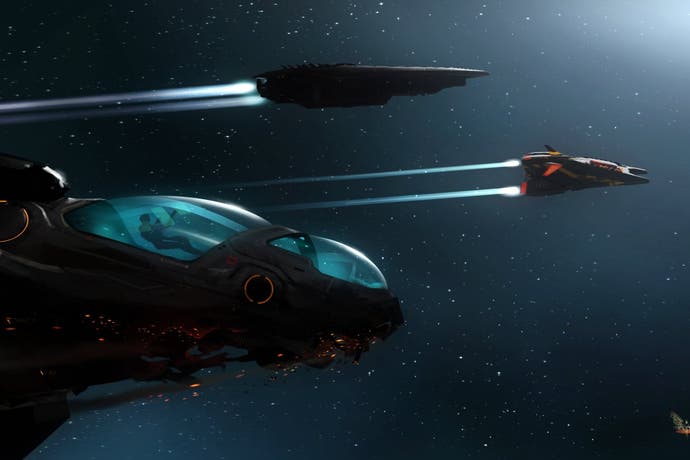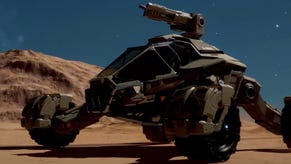Elite: Dangerous review
Haul or nothing.
Elite: Dangerous is a game about graft. It's about taking the long way round, clawing your way towards an ever-changing definition of success by any means necessary. The long-awaited fourth entry in the space trading simulation series, arriving exactly 30 years after the original, it's no surprise that Elite's roots lie in the Britain of the 1980s. This is Thatcherism on a cosmic scale, Norman Tebbit's advice to "get on your bike" filtered through the Star Wars generation.
As you'd expect, much like the social systems it allegorically echoes, Elite: Dangerous is at its best once you've broken through the glass ceiling and are comfortably off.
To begin with, it's pure toil. You enter the game with a feeble ship and just 1000 credits to your name. The Sidewinder is a craft that is useful for practically nothing. It has weapons that will barely scratch a better-equipped foe and a tiny cargo hold that might net you a few hundred credits in profit if you're lucky. From these meagre beginnings, you start to eke out a living in the hope of buying a better craft and shifting from sheep to wolf.
It sounds rather joyless, but while these initial hours might be a drag in terms of what must be done, the experience is sweetened enormously by what is probably the most immersive and compelling recreation of deep space ever seen in gaming. It's no wonder some fans have constructed elaborate, multi-monitor pretend cockpits in their spare rooms or plugged into Oculus Rift. Even without those technical assists - even when played on a small monitor - this is still a game where you feel like you're floating in a tin can like Major Tom, the frigid void outside the canopy and only your piloting skills between you and the merciless cosmic turbulence and gravitational forces that could snuff you out in seconds.
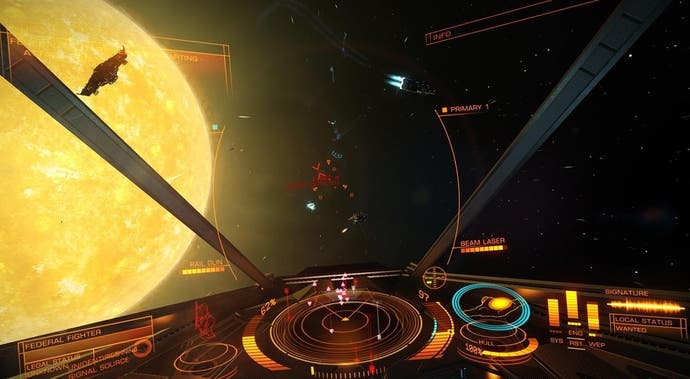
It's bracing stuff, and it reaches its crescendo with your first long-distance hyperspace jump. This headlong kaleidoscopic rush is a thrill from start to end, as you plot a course, line yourself up, and wait for the Frame Shift Drive to charge. As you hurtle through the wormhole, streaking starlight strobing across your cockpit interior, you are Han Solo, Captain Kirk, Buck Rogers or whichever space adventurer you prefer.
These are the immediate pleasures of Elite: Dangerous, and they're pretty intoxicating. They're just not quite enough to fully mask the repetitive nature of the mechanics underneath, nor the game's often distracting disregard for new players.
Progress quickly becomes cyclical. Jump to a station, dock, check the bulletin boards for jobs you can actually take on in your rubbish Sidewinder. Jump to your destination, rinse and repeat. Thanks to the limitations of your starter craft, that's really all you can do in order to slowly accrue the credits needed to choose a better ship and kit it out to your liking.
There is a difference between the unsentimental, bootstraps philosophy Elite traditionally promotes and just not bothering to explain stuff. Dangerous too often falls on the wrong side of that line. There are training missions and, now the game is in full release, there are links to official tutorial videos as well. Even so, there are many core functions and features that are either poorly illustrated or not mentioned at all.

One of the most noticeable - and most infuriating - is the simple matter of landing your ship. Once you've requested docking permission with a station and made your way to your designated landing pad, your scanner is replaced with a hologram of your ship once you get close enough to land. You position yourself with lateral thrusts and gentle throttle until you're lined up with the target beneath. You know when this is right, as the dots align and light up blue. Except, sometimes you'll lower yourself to the pad and nothing happens. That's because you also have to be facing the right way - towards the control tower - and not only does nothing in the game, training missions or tutorials explain this, but the game confuses matters further by giving all the indications that you're OK to land, even when you're not.
It's a maddening, bizarre oversight and one that leaves new players utterly confused. Some take to the forums thinking they've experienced a bug, or else come up with elaborate imagined solutions that work by accident. It's an extreme example, but it's typical of a game that will often send you to message boards or YouTube to work something out - often something quite basic - breaking that precious immersion every time.
Part of me wonders if this is just the nature of a crowd-funded niche game, developed by and for a community that is assumed to know all this stuff by the time they boot up. Exclusivity is inherent in the game's title, of course, but there are times when Elite feels very much like a game that doesn't want to be understood - except by those who have invested not only in gameplay hours, but the development process itself.
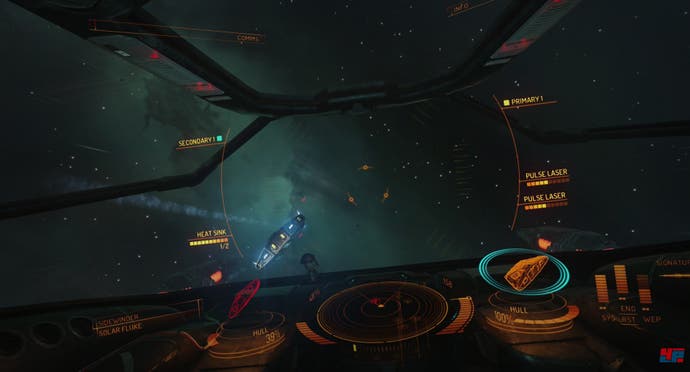
Many will be driven away by the obtuse nature of the game and its uphill grind, and that's a shame. Put in the hours, cut through the opacity of the systems, and Elite: Dangerous unfurls like a gorgeous flower and becomes one of the most enjoyable games of the year. Up to this point, you've had to make do with what you're given, from rudimentary delivery missions to bog-standard equipment. Scrape together your first 100,000 credits, however, and the much-vaunted freedom of choice finally comes into play.
You can become a bold bounty hunter, tracking your quarry from system to system. You can be a Federation hero, putting down criminals and rebels, earning plaudits along the way. You can be the entrepreneur, ferrying luxuries across light years in search of the biggest payday, or a miner, risking life and limb in remote asteroid belts, scooping up rare minerals. You may even choose to just head out into the blackness, discovering new stars and planets, selling your cartographic knowledge at remote outposts in exchange for enough credits to fund your next jaunt.
It's no exaggeration to say that once I reached this point, I fell in love with Elite all over again. Those hours I poured into Frontier: Elite 2 came flooding back. I still remember - still miss - the ship I owned in that game, a snub-nosed beast of a freighter with weaponry to spare. Elite: Dangerous replicates that sense of ownership and investment, though it makes you work harder to earn it.
Inevitably, though, the lustre does start to wear off eventually. This is a very mechanistic game, and even once you've kitted yourself out with a desirable ship and all the best guns and gadgets, the cycles you go through don't change much. Nor does the scenery. You can travel hundreds of light years from where you started, yet the space stations you dock with look the same, the system interfaces remain identical, the soft computer voice that welcomes you to each new port is the same.
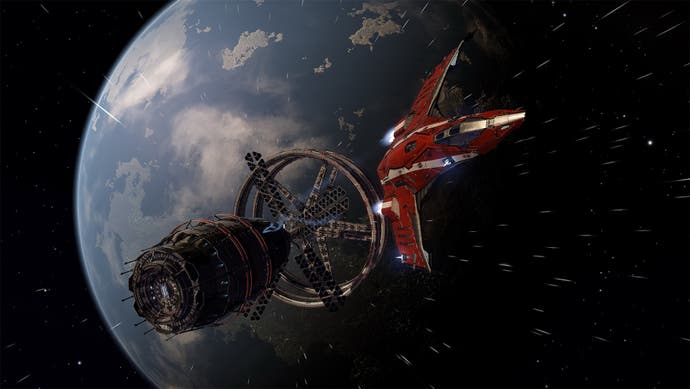
In its current state, it's a game with a lot of soul but very little personality. Just as the endless quest to acquire and consume in real life ultimately rings hollow, so too does Elite's upwardly mobile trajectory. It has the sheer scale needed to sell the notion of space travel, with billions of stars and planets to visit, but it feels like less of a journey when your only interaction with them is via the same few station designs and the same sterile menus. Is it a commentary on the homogenisation of the real world, where you can travel to the other side of the planet and still find a McDonalds and Starbucks? Or is it just that populating a game universe this vast with unique cultures and features is simply too big a task? I suspect the latter, but hope that Frontier does something to add some life to its cosmos.
For now, that life comes via other players, and this is a mixed blessing. Personally, I found that the presence of other human pilots weakened the game's immersion rather than deepening it. Whether it's new players cluttering up landing pads or colliding with you as you dock, or experienced players hanging around popular outposts to destroy easy targets, only a few seem to actually get into the role-playing aspect. Far from feeling like a universe populated by pilots, it feels like a space full of computer game players.
That could just be me, though. I'm not generally a fan of such "throw everyone in together and see what happens" experiments, preferring to keep my adventures distinct and unsullied by trolls and idiots. You can do that by opting for a solo game - though this is famously not the same as an offline game. The political state of the star systems and the in-game trading are still tied to what everyone else is doing. Trading is by far the game's weakest aspect right now - with too many stations offering limited cargo and minimal profits - and this may well be down to the community-driven economy. If so, rather than creating a lively, vibrant setting, it seems to be creating the cosmic equivalent of a dying provincial high street.
There's a lot of balancing to be done in the long term, then, and the big hurdle for new players will be getting up to speed without losing interest in those stodgy early hours. The mid-point, where everything coalesces, is so liberating, so brilliant in its scope and possibility, that it's hard to be too upset about these wrinkles. For all its frustrations, you'll spend much longer in the sweet spot than you spend getting there. Elite: Dangerous demands much, but repays your devotion many times over.
